9 Plumbago Varieties for a Beautiful Blue Garden
Author: Jen Worst | Editor: Omar Alonso
Review & Research: Jen Worst & Chris Miller

Native to tropical and temperate lands around the world, the perennial plumbago varieties are loved for their gorgeous, abundant blue blooms and long-lasting nature, making them a great addition to flower bowls and gardens everywhere.
The plant is quite hardy, able to withstand drought conditions, and hardly prone to any diseases or pests.
9 Plumbago Varieties
If you’re looking to add a plumbago plant to your garden, you’ll first have to decide what variety you’d like to go with! Here’s a breakdown of the different types of plumbago.
Plumbago Auriculata
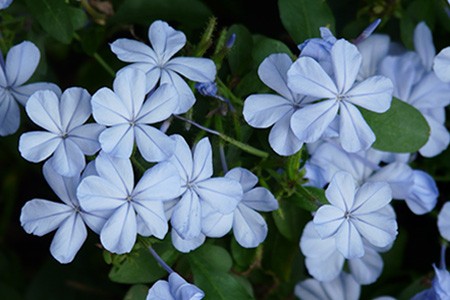
Cape plumbago, sky flower, blue plumbago, and cape leadwort—Plumbago auriculata is a plant of many names, but it is the first plant that comes to mind when someone says “leadwort” since they’re so abundantly found.
Named for their ear-shaped leaves, these plants are originally South African residents but can grow well in warm, dry climes in general. This means that they’re just as likely to thrive in regions such as Texas and Florida.
Plumbago auriculata plants grow fast, blooming in violet, pale blue, or deep blue phlox-like spurts when the flowering season occurs (which can be throughout the year in the right conditions).
The individual blooms are cup-shaped and five-petalled, while the leaves are broad, ovoid, and as mentioned earlier, ear shaped. The leaves can reach maximum lengths of three inches.
Plumbago auriculata is also referred to as “imperial blue”, given the color of the flowers. Some folks swear by the deemed medicinal properties of this plant, using it to treat warts, headaches, wounds, and even bad dreams.
Plumbago auriculata plants require regular maintenance, with frequent pruning and shaping to ensure healthy growth. These plants, like all plumbago varieties, are quite hardy, with the ability to withstand extreme conditions and even drought. They thrive in direct sunlight but can still manage in partial sunlight.
Plumbago Indica
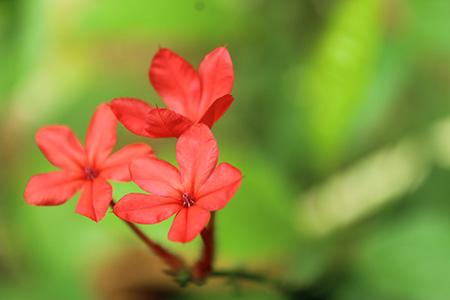
The vibrant coloring of the Plumbago indica’s flowers has also earned it the moniker “scarlet plumbago”. This plant’s stunning deep-red/scarlet blossoms have won many hearts and gardens across the country.
Also referred to as scarlet leadwort and Indian leadwort, the scarlet plumbago types are native to Southeast Asia, growing abundantly in countries such as India, Indonesia, China, and Pakistan.
Therefore, it does well in regions with similar temperatures and rainfall conditions, which, in the USA, is in areas such as Florida and the Gulf Coast that are sunny and humid throughout the year.
This plant can reach a maximum height of two feet and a maximum width of three feet. Scarlet plumbago also prefers partial sunlight. their red color matches so well with red types of tulips, which is a good way to bring variety and diversity to your flowerbed.
While scarlet plumbago can add a lovely pop of color to your yard, be careful if you’re growing this plant in your garden or home; scarlet plumbago is poisonous and can be toxic to pets and kids.
Plumbago Pulchella
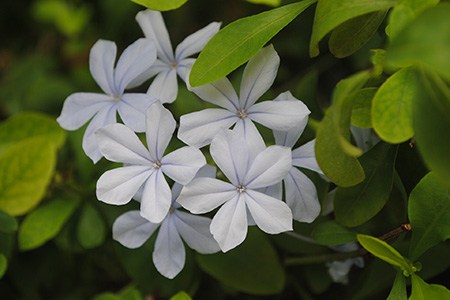
Found in over 20 states in its native country of Mexico, Plumbago pulchella is locally known as cola de iguana—Spanish for the tail of the iguana! The plant gets this strange name thanks to its physical characteristics, more specifically its thorny green stem with red markings that greatly resemble its namesake.
When the plant blooms, the flowers are tubular, star-shaped, and either violet or lilac, growing up the thin stalk in an alternating manner.
Cola de iguana is highly prized among Mexico’s natives, especially the indigenous peoples such as the Mesoamericans and the Raramuri, for its place in traditional healing techniques and medicine.
The plant is rich in a compound called pulchellidin (the root of its Latin name), which is purported to help with a range of diseases in both humans and animals.
Plumbago Zeylanica
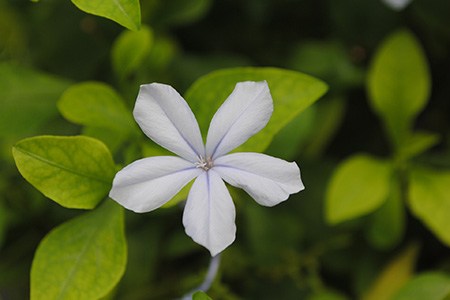
One more plumbago variety that hails from India, these plants are locally known as safed chitrak (meaning “white flowers”) and Ceylon leadwort.
Typically found in Bengal, Gujarat, Uttar Pradesh, Maharashtra, and parts of South India, the Plumbago zeylanica’s white flowers are quite different from its Indian cousin, the Indian leadwort—Ceylon leadwort has tiny white flowers, unlike the Indian leadwort’s larger scarlet blooms.
Apart from the Indian subcontinent, you’ll also find Plumbago zeylanica growing abundantly in Australia’s forests and tropical regions, where it is also known as doctorbush for its medicinal values and wild leadwort due to its wild, unaided growth in the wilderness.
Plumbago zeylanica flowers require high temperatures for blooming, which is generally between the months of February and August in their native lands.
The plant is also an Ayurvedic staple, exalted for its purported antifungal, antioxidant, anti-carcinogenic, and antibacterial due to its key ingredient plumbagin. Plumbago zeylanica is supposedly helpful with skin diseases, reducing the size of tumors, and healing wounds in Ayurveda.
Plumbago Europaea
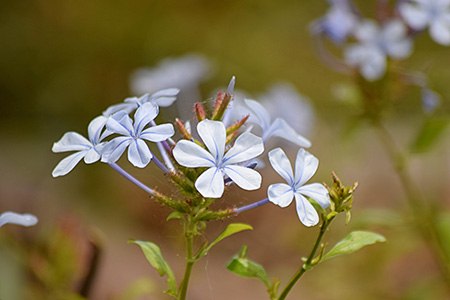
Also known as European plumbago and common leadwort, the Plumbago Europaea variety is native to the regions of the Middle East, the Mediterranean, Central Asia, and the majority of southern Europe—hence, the name.
The plant was popularly used as ornamentation on fences in many European countries such as Romania, Albania, Portugal, Spain, Bulgaria, Greece, and France, but was also quite commonly found on the beaches, too.
The flowers of these plumbago varieties are quite distinct, with a central barbed fruit cone and a lovely hue running from lilac to dusty pink. The petals also droop outwards. Not only do they look a lot like types of lilacs in shape, but even in color you could easily confuse them.
The stem is quite woody and can grow to maximum heights of around 47 inches, while the leaves can be any shade from reddish-brown to green and grow to around 3 inches at most.
European leadworts are rich in flavonoids, the phytonutrients responsible for the vibrant coloring of the plant’s fruits and flowers. These flavonoids also exhibit anti-inflammatory and antibacterial values, which makes them a common cure for treating skin conditions, especially in traditional Turkish medical practices.
If you’re growing European leadworts at home, ensure that the soil is gritty or sandy and well-draining, with sufficient sunshine. The best planting period is after winter so that the plants receive as much exposure to warm temperatures as possible.
Ceratostigma Griffithii
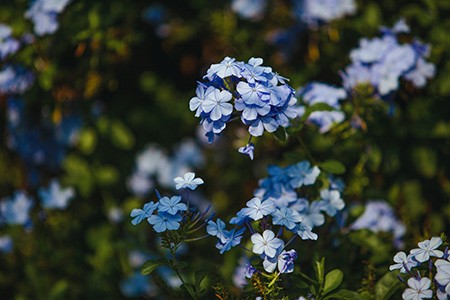
Also referred to as Burmese plumbago, Griffith’s plumbago, and Griffith’s blue leadwort, this variety loves warm climes and sunlight (partial or full).
These plants can grow up to three feet in height, reaching their maximum height around five years into their lifespans. Burmese plumbago flower in the months between mid-summer and late fall, with green leaves for the majority of the year (the leaves may turn red and shed during fall).
The flowers of the Burmese plumbago, a gorgeous cerulean blue, have subtle ruffles at the ends of the petals, contributing to the plant’s elegance. Burmese plumbago is quite hardy, with the ability to easily tolerate drought.
Plumbago Wissii
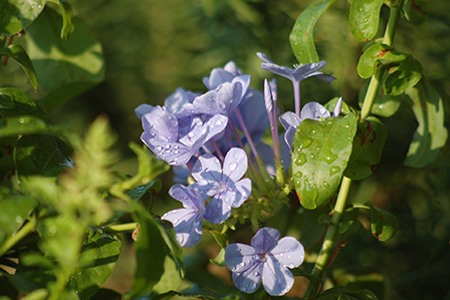
Plumbago wissii are named after the Namibian farmer and naturalist who discovered them in 1955 and are indigenous to the country’s rocky inland cliffs. This variety features multiple stems and can grow up to be quite tall.
The leaves are fleshy, long, and narrow, adapted to absorbing and retaining sufficient moisture to survive their native land’s harsh weather conditions.
Plumbago wissii enjoys hot temperatures and sandy soil, easily multiplying in such conditions. The flowers range from a lovely maroonish-purple to plain purple and remain open throughout the day.
Ceratostigma Willmottianum
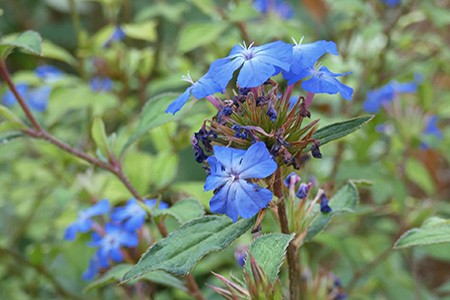
Quite short in comparison to other plumbago varieties (it only reaches a maximum height and width of four feet), the Ceratostigma willmottianum is also referred to as Chinese plumbago.
This variety has blue flowers with petals that are subtly triangular and have straight, smooth ends, though the corners are rounded. These plants do well in both partial and full sunlight, but well-draining soil is a must.
Ceratostigma Plumbaginoides
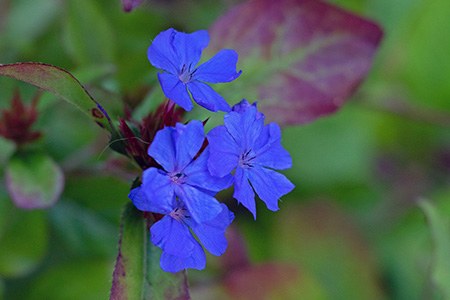
Also known as hardy plumbago and blue leadwort, Ceratostigma plumbaginoides is a variety that’s indigenous to China. This plant is a wiry shrub that’s quite rhizomatous, and in its home country, is popularly used as a natural carpet to cover the ground alongside a chamomile lawn.
Hardy plumbago plants grow quite quickly, thriving in full sunlight (though they can also manage growth in partial sunlight). The flowers of this variety are a lovely deep blue or cobalt shade.
Other Plumbago Varieties
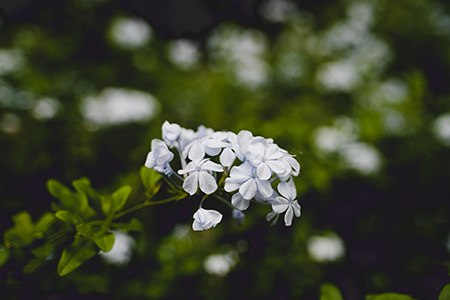
Though the varieties mentioned above are the most popular plumbago types, there are a few other types of plumbago found across the world, such as:
- Plumbago ciliata
- Plumbago aphylla
- Plumbago glandulicaulis
- Plumbago dawei
- Plumbago amplexicaulis
- Plumbago coerulea
- Plumbago pearsonii
- Plumbago montis-elgonis
- Plumbago madagascariensis
- Plumbago tristis
- Plumbago stenophylla
All the varieties of plumbago differ from each other in some aspects but mostly have the same general characteristics.
Types of Plumbago to Splash Blue in Your Flower Bed
Plumbago plants are extremely beautiful, and for a while, were restricted to growing only on the sidewalks and wilderness—albeit beautifully—in their native lands.
If you’re thinking of adding a plumbago plant to your garden, consider any of the above easily found types and watch your garden glow in myriad hues.
With more people taking notice of how easy they are to grow and how they can instantly spruce up their garden or gorgeously carpet it, plumbago varieties are making their way into more yards and gardens everywhere.



